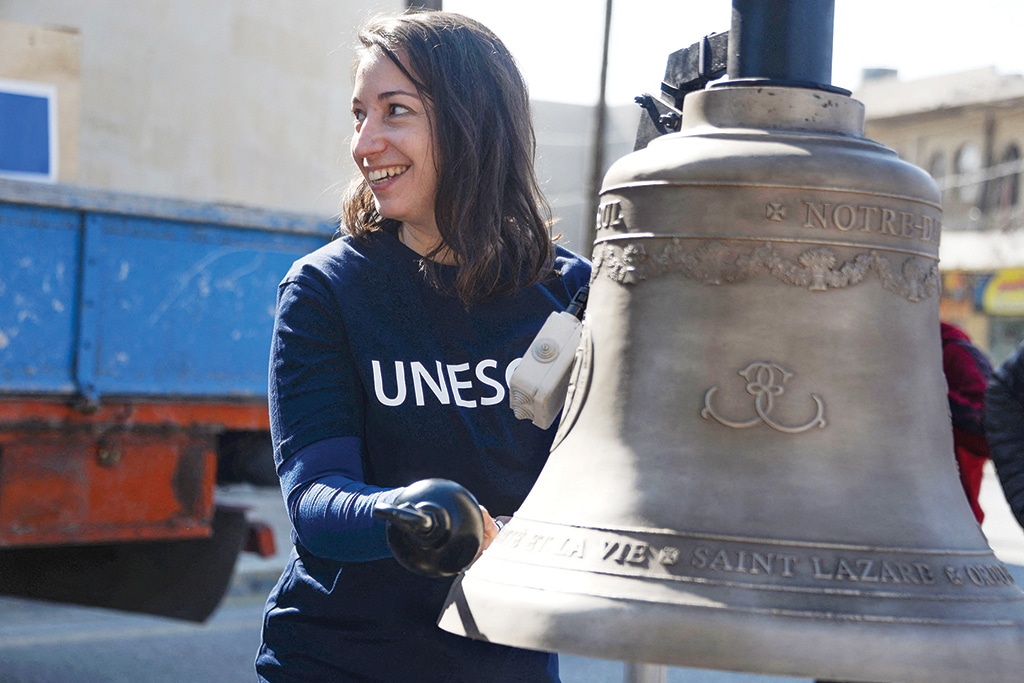MOSUL:┬Ā Where brutal jihadists once ruled in Iraq, church bells rang out on Tuesday, a symbol of hope, reconstruction, and unity. ŌĆ£They ring for everyone,ŌĆØ the UNŌĆÖs cultural chief Audrey Azoulay said on a visit to the northern metropolis of Mosul, IraqŌĆÖs second city.
Her agency, UNESCO, is rebuilding churches, mosques and other buildings devastated by the Islamic State groupŌĆÖs three-year occupation of a city known for its religious and cultural diversity. ŌĆ£ItŌĆÖs a symbol of a return to peace, connection to history but also a symbol of hope for the future,ŌĆØ said Azoulay, director-general of the United Nations Educational, Scientific and Cultural Organization.
She spoke on the second day of a visit to demonstrate UNESCOŌĆÖs support for the rebuilding of Iraq, whose rich heritage has been ravaged by conflict over the past 20 years. Since 2018 UNESCO has raised more than $150 million for projects in Iraq, mostly the reconstruction of Mosul.
IS seized the city as its stronghold before being pushed out in 2017, but the battle to retake it reduced the Old City to rubble. Under UNESCOŌĆÖs ŌĆ£Revive the Spirit of MosulŌĆØ initiative, mosques, churches and century-old homes are being rebuilt.
The sound of dialogue
Among the most prominent of the restorations is Our Lady of the Hour convent, where the three church bells newly arrived from France pealed from the bell tower where they have just been installed.
Known in Arabic as Al-Saa, the clock church, it was named for a timepiece given by France in 1880 to recognise the DominicansŌĆÖ cultural and social work.┬ĀAzoulay said the convent provided IraqŌĆÖs first school for girls and first teachersŌĆÖ college for women. The site also hosted the first printing press in Mesopotamia, she said.
Its three new bronze bells, named after the archangels Gabriel, Michael and Raphael, the heaviest of which weighs 270 kilograms (168 pounds). They were cast at the same French foundry in Normandy which made those at Notre-Dame Cathedral in Paris, said Azoulay, a former French culture minister.
ŌĆ£We are in a place of religion, of culture, of coexistence, of education... very symbolic place,ŌĆØ she said.┬ĀThe walls of the convent church have been restored with ŌĆ£magnificent stone, gilded a little like breadŌĆØ, said Dominican Father Olivier Poquillon.
UNESCO is also restoring MosulŌĆÖs Al-Nuri mosque and the adjacent landmark minaret nicknamed Al-Hadba or the ŌĆ£hunchbackŌĆØ, which dates from the 12th century. They were destroyed during the battle to retake the city from IS. IraqŌĆÖs army accused IS of planting explosives at the site and blowing it up.
The jihadistsŌĆÖ arrival further decimated an Iraqi Christian population which has lived in the region for millenia. Since the 2003 US-led overthrow of Saddam Hussein, IraqŌĆÖs Christian community has shrunk to about 400,000.
Still, ŌĆ£we are seeing life return to the area,ŌĆØ Poquillon said late last month as he supervised installation of the bells which he hopes will regain ŌĆ£a function of dialogueŌĆØ.┬ĀIn MosulŌĆÖs Old City, the church bells and the mosque minaret are neighbours and people can hear them both calling their faithful to prayer, he said. - AFP











